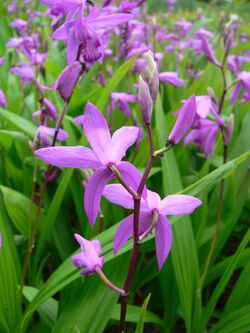Biology:Bletilla striata
| Bletilla striata | |
|---|---|

| |
| Scientific classification | |
| Kingdom: | Plantae |
| Clade: | Tracheophytes |
| Clade: | Angiosperms |
| Clade: | Monocots |
| Order: | Asparagales |
| Family: | Orchidaceae |
| Subfamily: | Epidendroideae |
| Tribe: | Arethuseae |
| Genus: | Bletilla |
| Species: | B. striata
|
| Binomial name | |
| Bletilla striata (Thunb.) Rchb.f. (1878)
| |
| Synonyms[1] | |
|
Synonyms list
| |
Bletilla striata, known as hyacinth orchid[2] or Chinese ground orchid,[3] is a species of flowering plant in the orchid family Orchidaceae, native to Japan, Korea, Myanmar (Burma), and China (Anhui, Fujian, Gansu, Guangdong, Guangxi, Guizhou, Hubei, Hunan, Jiangsu, Jiangxi, Shaanxi, Sichuan, Zhejiang).[1][4] It is most commonly found growing in clumps alongside grassy slopes with sandy soil.[5]
The Latin specific epithet striata means "striped", in reference to the ribbed leaves.[6]
Description
Bletilla striata is a terrestrial orchid with pleated, spear-shaped leaves. It breaks dormancy in early spring, with each tuber of the previous year potentially sending out multiple shoots. These growths mature over the course of a couple months and eventually bear 3-7 magenta-pink flowers.[7]
Cultivation
In cultivation in the United Kingdom it is hardy in sheltered locations down to −10 °C (14 °F). It has gained the Royal Horticultural Society's Award of Garden Merit.[2]
In the U.S. it may be grown in USDA hardiness zones 5–9, although a winter mulching for plants grown in zone 5 is recommended.[7]
Like most terrestrial orchids, it drops its leaves as it enters winter dormancy; however, it tolerates moisture during this period much better than most others. Nevertheless, it is encouraged to grow Bletilla striata in a well-draining, humus-rich mix.[8]
Uses
Bletilla striata is used in Asian traditional medicine for treating problems with the lining of the alimentary canal, e.g. ulcers.[9]
It is also used as a natural glue for making silk strings for traditional Chinese instruments like the guqin.[10]
References
- ↑ 1.0 1.1 Kew World Checklist of Selected Plant Families
- ↑ 2.0 2.1 "RHS Plantfinder - Bletilla striata". https://www.rhs.org.uk/Plants/2323/i-Bletilla-striata-i/Details. Retrieved 12 January 2018.
- ↑ (xls) BSBI List 2007, Botanical Society of Britain and Ireland, https://bsbi.org/download/3542/, retrieved 2014-10-17
- ↑ Flora of China v 25 p 210, 白及 bai ji, Bletilla striata
- ↑ Ōi, Jisaburō. Flora of Japan (English translation). The Smithsonian Institution, 1965
- ↑ Harrison, Lorraine (2012). RHS Latin for Gardeners. United Kingdom: Mitchell Beazley. ISBN 978-1845337315.
- ↑ 7.0 7.1 "MO Botanical Garden - Bletilla striata". https://www.missouribotanicalgarden.org/PlantFinder/PlantFinderDetails.aspx?taxonid=283860&isprofile=0&. Retrieved 18 December 2018.
- ↑ "Phytesia - Bletilla". http://www.phytesia.com/en/cultivation-how-to-grow-hardy-orchids.php?genre=1. Retrieved 18 December 2018.
- ↑ Chunming Wang; Jiantao Sun; Yi Luo; Weihua Xue; Huajia Diao; Lei Dong; Jiangning Chen; Junfeng Zhang (2006). "A Polysaccharide Isolated from the Medicinal Herb Bletilla striata Induces Endothelial Cells Proliferation and Vascular Endothelial Growth Factor Expression in vitro". Biotechnology Letters 28 (8): 539–543. doi:10.1007/s10529-006-0011-x. PMID 16614890.
- ↑ Yu-Ku-Chai translation - Volume 3, Chapter 9: The Method for Making Strings http://web.cecs.pdx.edu/~jrb/chin/v39/v39.htm
External links
| Wikimedia Commons has media related to Bletilla striata. |
Wikidata ☰ Q159003 entry
 |

